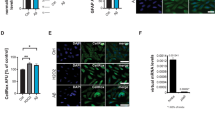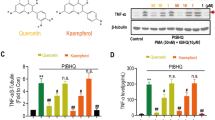Abstract
Tangeretin, a flavonoid from citrus fruit peels, has been proven to play an important role in anti-inflammatory responses and neuroprotective effects in several disease models, but further study is necessary for elucidating the detailed mechanisms of these effects. In this study, we examined the anti-inflammatory effect of tangeretin in lipopolysaccharide (LPS)-stimulated microglia. We first observed that tangeretin inhibited LPS-induced production of nitric oxide, tumor necrosis factor alpha, interleukin (IL)-6, and IL-1β, as well as LPS-induced mRNA expression of inducible nitric oxide synthases and cytokines. Additionally, we found that the activities, mRNA levels, and protein levels of matrix metalloproteinase (MMP)-3 and MMP-8 were inhibited, while the expression of tissue inhibitor of metalloproteinase-2 was enhanced by tangeretin in LPS-stimulated microglia. Further mechanistic study showed that tangeretin suppressed LPS-induced phosphorylation of mitogen-activated protein kinases and Akt. Also, tangeretin inhibited nuclear factor-κB by upregulating sirtuin 1 and 5′-adenosine monophosphate-activated protein kinase. We further demonstrated the antioxidant effect of tangeretin by showing that tangeretin inhibited reactive oxygen species production and p47phox phosphorylation, while enhancing the expression of heme oxygenase-1 and the DNA binding activity of nuclear factor-erythroid 2-related factor 2 to the antioxidant response element in LPS-stimulated microglia. Taken together, the results of the present study demonstrate that tangeretin possesses a potent anti-inflammatory and antioxidant effect in microglia.






Similar content being viewed by others
References
Alhakm ani F, Kumar S, SA K, Ahmad A (2013) Estimation of total phenolic content, in vitro antioxidant and anti-inflammatory activity of flowers of Moringa oleifera. Asian Pac J Trop Biomed 3:623–627
Bocchini V, Mazzolla R, Barluzzi R, Blasi E, Sick P, Kettenmann H (1992) An immortalized cell line expresses properties of activated microglial cells. J Neurosci Res 31:616–621
Cherry JD, Olschowka JA, O’Banion MK (2014) Neuroinflammation and M2 microglia: the good, the bad, and the inflamed. J Neuroinflammation 11:98
Choi SY, Ko HC, Ko SY, Hwang JH, Park JG, Kang SH, Han SH, Yun SH, Kim SJ (2007) Correlation between flavonoid content and the NO production inhibitory activity of peel extracts from various citrus fruits. Biol Pharm Bull 30(4):772–778
Datla KP, Christidou M, Widmer WW, Rooprai HK, Dexter DT (2001) Tissue distribution and neuroprotective effects of citrus flavonoid tangeretin in a rat model of Parkinson’s disease. Neuroreport 12(17):3871–3875
Ferreres F, Grosso C, Gil-Izquierdo A, Valentao P, Andrade PB (2013) Phenolic compounds from Jacaranda caroba (vell.) A. DC: approaches to neurodegenerative disorders. Food Chem Toxicol 57:91–98
Glass CK, Saijo K, Winner B, Marchetto MC, Gage FH (2010) Mechanisms underlying inflammation in neurodegeneration. Cell 140:918–934
Graeber MB, Streit WJ (2010) Microglia: biology and pathology. Acta Neuropathol 119:89–105
Halliwell B (2006) Oxidative stress and neurodegeneration: where are we now? J Neurochem 97(6):1634–1658
Heiman A, Pallottie A, Heary RF, Elkabes S (2014) Toll-like receptors in central nervous system injury and disease: a focus on the spinal cord. Brain Behav Immun 42:232–245
Ho SC, Kuo CT (2014) Hesperidin, nobiletin, and tangeretin are collectively responsible for the anti-neuroinflammatory capacity of tangerine peel (Citri reticulatae pericarpium). Food Chem Toxicol 71:176–182
Hsieh HL, Yang CM (2013) Role of redox signaling in neuroinflammation and neurodegenerative diseases. Biomed Res Int 2013:484613
Jana M, Jana A, Liu X, Ghosh S, Pahan K (2007) Involvement of phosphatidylinositol 3-kinase-mediated up-regulation of IκBα in anti-inflammatory effect of gemfibrozil in microglia. J Immunol 179:4142–4152
Jang SE, Ryu KR, Park SH, Chung S, Teruya Y, Han MJ, Woo JT, Kim DH (2013) Nobiletin and tangeretin ameliorate scratching behavior in mice by inhibiting the action of histamine and the activation of NF-κB, AP-1 and p38. Int Immunopharmacol 17:502–507
Keum YS (2012) Regulation of Nrf2-mediated phase II detoxification and anti-oxidant genes. Biomol Ther 20:144–151
Lee EJ, Han JE, Woo MS, Shin JA, Park EM, Kang JL, Moon PG, Baek MC, Son WS, Ko YT, Choi JW, Kim HS (2014a) Matrix metalloproteinases-8 plays a pivotal role in neuroinflammation by modulating TNF-α activation. J Immunol 193(5):2384–2393
Lee EJ, Kim HS (2014) The anti-inflammatory role of tissue inhibitor of metalloproteinase-2 in lipopolysaccharide-stimulated microglia. J Neuroinflammation 11:116
Lee EJ, Ko HM, Jeong YH, Park EM, Kim HS (2015a) β-Lapachone suppresses neuroinflammation by modulating the expression of cytokines and matrix metalloproteinases in activated microglia. J Neuroinflammation 12:133
Lee EJ, Moon PG, Baek MC, Kim HS (2014b) Comparison of the effects of matrix metalloproteinase inhibitors on TNF-α release from activated microglia and TNF-α converting enzyme activity. Biomol Ther 22(5):414–419
Lee EJ, Woo MS, Moon PG, Baek MC, Choi IY, Kim WK, Junn E, Kim HS (2010) α-synuclein activates microglia by inducing the expressions of matrix metalloproteases and the subsequent activation of protease-activated receptor-1. J Immunol 185:615–623
Lee KM, Kang HS, Yun CH, Kwak HS (2012) Potential in vitro protective effect of quercetin, catechin, caffeic acid and phytic acid against ethanol-induced oxidative stress in SK-hep-1 cells. Biomol Ther 20:492–498
Lee YY, Park JS, Lee EJ, Lee SY, Kim DH, Kang JL, Kim HS (2015b) Anti-inflammatory mechanism of ginseng saponin metabolite Rh3 in lipopolysaccharide-stimulated microglia: critical role of 5′-adenosine monophosphate-activated protein kinase signaling pathway. J Agric Food Chem 63(13):3472–3480
Melo A, Monteiro L, Lima RM, Oliveira DM, Cerqueira MD, El-Bacha RS (2011) Oxidative stress in neurodegenerative diseases: mechanisms and therapeutic perspectives. Oxidative Med Cell Longev 2011:467180
Middleton E, Kandaswami C, Theoharides TC (2000) The effect of plant flavonoids on mammalian cells: implications for inflammation, heart disease, and cancer. Pharmacol Rev 52(4):673–751
Park JS, Park EM, Kim DH, Jung K, Jung JS, Lee EJ, Hyun JW, Kang JL, Kim, H.S (2009) Anti-inflammatory mechanism of ginseng saponins in activated microglia. J Neuroimmunol 209:40–49
Rooprai HK, Kandanearatchi A, Maidment SL, Crhistidou M, Trillo-Pazos G, Dexter DT, Rucklidge GJ, Widmer W, Pilkington GJ (2001) Evaluation of the effects of swainsonine, captopril, tangeretin and nobiletin on the biological behavior of brain tumour cells in vitro. Neuropathol Appl Neurobiol 1:29–39
Rosenberg GA (2009) Matrix metalloproteinases and their multiple roles in neurodegenerative diseases. Lancet Neurol 8:205–216
Salminen A, Hyttinen JMT, Kaarniranta K (2011) AMP-activated protein kinase inhibits NF-κB signaling and inflammation: impact on healthspan and lifespan. J Mol Med 89:667–676
Salminen A, Kaarniranta K (2012) AMP-activated protein kinase (AMPK) controls the aging process via an integrated signaling network. Ageing Res Rev 11:230–241
Salt IP, Palmer TM (2012) Exploiting the anti-inflammatory effects of AMP-activated protein kinase activation. Expert Opin Invest Drugs 21(8):1155–1167
Sofroniew MV (2015) Astrocyte barriers to neurotoxic inflammation. Nat Rev Neurosci 16:249–263
Shu Z, Yang B, Zhao H, Xu B, Jiao W, Wang Q, Wang Z, Kuang H (2014) Tangeretin exerts anti-inflammatory effects via NF-κB modulation in lipopolysaccharide-stimulated microglial cells. Int Immunopharmacol 19(2):275–282
Theoharides TC, Valent P, Akin C (2015) Mast cells, mastocytosis, and related disorders. N Engl J Med 323(2):163–172
Tominari T, Hirata M, Matsumoto C, Inada M, Miyaura C (2012) Polymethoxy flavonoids, nobiletin and tangertetin, prevent lipopolysaccharide-induced inflammatory bone loss in an experimental model for periodontitis. J Pharmacol Sci 119:390–394
Torres M (2003) Mitogen-activated protein kinase pathways in redox signaling. Front Biosci 8:d369–d391
Uttara B, Singh AV, Zamboni P, Mahajan RT (2009) Oxidative stress and neurodegenerative diseases: a review of upstream and downstream antioxidant therapeutic options. Curr Neuropharmacol 7(1):65–74
Van Lint P, Libert C (2007) Chemokine and cytokine processing by matrix metalloproteinases and its effect on leukocyte migration and inflammation. J Leukoc Biol 82(6):1375–1381
von Bernhardi R, Eugenin J (2012) Alzheimer’s disease: redox dysregulation as a common denominator for diverse pathogenic mechnisms. Antioxid Redox Signal 16(9):974–1031
Wasila H, X LI, Liu L, Ahmad I, Ahmad S (2013) Peel effects on phenolic composition, antioxidant activity, and making of pomegranate juice and wine. J Food Sci 78:1159–1165
Woo MS, Jang PG, Park JS, Kim WK, Joh TH, Kim HS (2003) Selective modulation of lipopolysaccharide-stimulated cytokine expression and mitogen-activated protein kinase pathways by dibutyryl-cAMP in BV2 microglial cells. Brain Res Mol Brain Res 113:86–96
Woo MS, Park JS, Choi IY, Kim WK, Kim HS (2008) Inhibition of MMP-3 or −9 suppresses lipopolysaccharide-induced expression of proinflammatory cytokines and iNOS in microglia. J Neurochem 106:770–780
Wu JJ, Cui Y, Yang YS, Jung SC, Hyun JW, Maeng YH, Park DB, Lee SR, Kim SJ, Eun SY (2013) Mild mitochondrial depolarization is involved in a neuroprotective mechanism of Citrus sunki peel extract. Phytother Res 27:564–571
Yang SR, Wright J, Bauter M, Seweryniak K, Kode A, Rahman I (2007) Sirtuin regulates cigarette smoke-induced proinflammatory mediator release via RelA/p65 NF-κB in macrophages in vitro and in rat lungs in vivo: implications for chronic inflammation and aging. Am J Physiol Lung Cell Mol Physiol 292:L567–L576
Acknowledgments
This research was supported by Basic Science Research Program through the National Research Foundation of Korea (NRF) funded by the Ministry of Science, ICT & Future Planning (Grant No. NRF-2010-0027945 and NRF-2015R1A2A2A01005226).
Author information
Authors and Affiliations
Corresponding author
Ethics declarations
Conflict of Interest
The authors declare no conflicts of interest.
Rights and permissions
About this article
Cite this article
Lee, Y.Y., Lee, EJ., Park, JS. et al. Anti-Inflammatory and Antioxidant Mechanism of Tangeretin in Activated Microglia. J Neuroimmune Pharmacol 11, 294–305 (2016). https://doi.org/10.1007/s11481-016-9657-x
Received:
Accepted:
Published:
Issue Date:
DOI: https://doi.org/10.1007/s11481-016-9657-x




